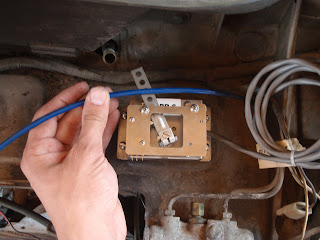The coupler is almost done, but it won't do any good without the motor attached to the transmission. I spent the past weekend getting the dimensions of the transmission housing so the adaptor plate could be machined.
I'm sure there are 100 better ways to do this, but here's my method... I took a sheet of posterboard and cut it roughly to fit around the transmission. I then punched a hole in the center for the transmission shaft.

Next I got out some shoe polish and started rubbing it along the transmission housing. When I push the posterboard against the transmission I should get a decent impression.

Pealing back the posterboard from the transmission...

I measured a few more dimensions and took a permanent thin tipped marker to draw out the bolt holes so they would show up a little bit better.

Then in AutoCad I drafted up the measurements of the housing shape and bolt locations. I don't have a large format printer, but after a short trip to Kinkos I had it printed on 17" x 22" paper. A quick test fit of the paper on the transmission...

Well it didn't fit quite perfect. Actually it was way off. The reason, I wrote down 4" instead of 5" for one of my bolt dimensions. Measure twice, cut once, oh well. So I fixed the dimensions, reprinted it at Kinkos, then test fitted it again on the transmission. Still off but very close. I adjusted a few of the bolt holes by a degree or so and re-reprinted it at Kinkos.
Success! Here are the final AutoCad plans:

And printed / cut out...

The transmission housing...

With the new adaptor plate template...

The motor...

With the new adaptor plate template...

I'll actually have the bolt holes drilled out a bit larger on the adaptor plate to give it some more wiggle room when its mounted. (Not that I don't trust my great tolerances! Right...) Now I just need to get to that machine shop... Matt, you free this next weekend?












































